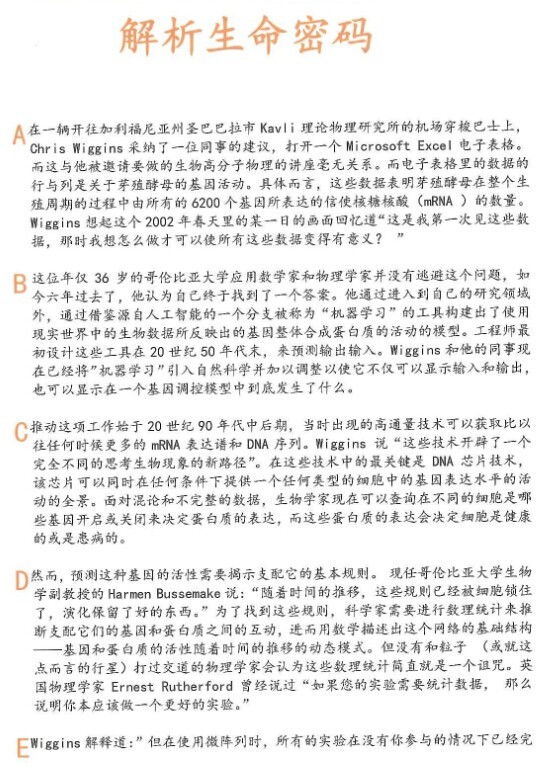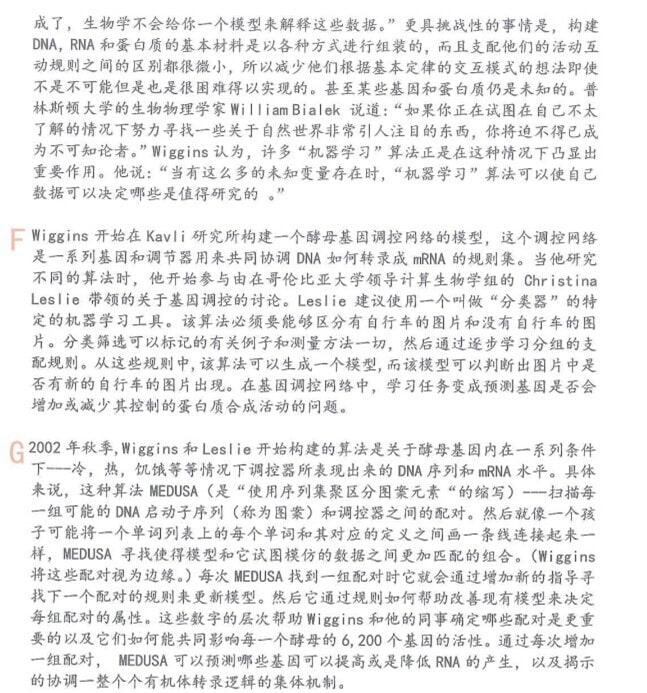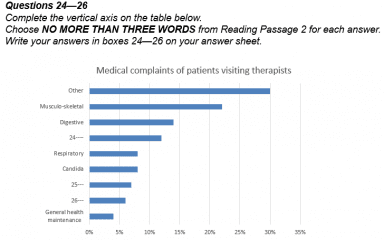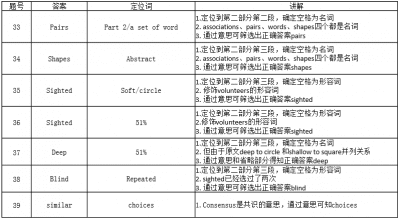雅思阅读表格填空题型解题5大步骤讲解
解题雅思阅读考试有一类小题型是雅思阅读表格填空(complete the table)。这类填空题出题频率较低,且难度不大。下面小编给大家带来了雅思阅读表格填空题型解题5大步骤讲解,希望能够帮助到大家,下面小编就和大家分享,来欣赏一下吧
雅思阅读表格填空题型解题5大步骤讲解
题型特点:
顺序原则 题目基本上按照文章顺序排列
字数限制 一般填入的词最多不超过3个单词
定位内容 定位的内容相对比较集中
考查内容 考查内容均为细节
答案特点 所填答案基本唯一
解题路线图:
①明确字数限制
•表格填空题解题过程中,考生必须培养第一步看字数限制的习惯。
②空格词性预判
• 根据空格前后的词性进行判断,
• 如adj+(n),n+(n),v+(n)等结构;
• 也可根据句子成分进行判断,
• 如空格为主语成分,基本为名词,表语成分基本为形容词
➂ 定位关键词
并分析定位句• 找到空格所在句子的关键词,并定位到文中相应位置对定位句进行分析。
• 注意空格所在句子中关键词与原文中的关键词替换;或空格所在句子的关键词是对原 文定位句的同义概括。
➃ 理解原文与题干的同意替换
• 词语的替换,即词与词之间的替换
• 短语的替换,即短语之间的替换
• 句子的替换,即句子之间的互换
• 展开陈述形式,即以解释的方式来诠释某个词、短语或概念
➄ 填出答案
• 结合关键句和行列信息得出应该填写的内容。
雅思阅读机经真题解析-Life code:unlocked
A
On an airport shuttle bus to the Kavli Institute for Theoretical Physics in Santa Barbara, Calif, Chris Wiggins took a colleague's advice and opened a Microsoft Excel spreadsheet. It had nothing to do with the talk on biopolymer physics he was invited to give. Rather the columns and rows of numbers that stared back at him referred to the genetic activity of budding yeast. Specifically, the numbers represented the amount of messenger RNA (mRNA) expressed by all 6,200 genes of the yeast over the course of its reproductive cycle. “It was the first time I ever saw anything like this," Wiggins recalls of that spring day in 2002. "How to make sense of all these data?"
B
Instead of shirking from this question, the 36-year-old applied mathematician and physicist at Columbia University embraced it-and now six years later he thinks he has an answer. By foraying into fields outside his own, Wiggins has drudged up tools from a branch of artificial intelligence called machine learning to model the collective protein-making activity of genes from real-world biological data. Engineers originally designed these tools in the late 1950s to predict output from input. Wiggins and his colleagues have now brought machine learning to the natural sciences and tweaked it so that it can also tell a story—one not only about input and output but also about what happens inside a model of gene regulation, the black box in between.
C
The impetus for this work began in the late 1990s, when high-throughput techniques generated more mRNA expression profiles and DNA sequences than ever before, "opening up a completely different way of thinking about biological phenomena," Wiggins says. Key among these techniques were DNA microarrays, chips that provide a panoramic view of the activity of genes and their expression levels in any cell type, simultaneously and under myriad conditions. As noisy and incomplete as the data were, biologists could now query which genes turn on or off in different cells and determine the collection of proteins that give rise to a cell's characteristic features- healthy or diseased.
D
Yet predicting such gene activity requires uncovering the fundamental rules that govern it. “Over time, these rules have been locked in by cells,” says theoretical physicist Harmen Bussemaker, now an associate professor of biology at Columbia. "Evolution has kept the good stuff." To find these rules, scientists needed statistics to infer the interaction between genes and the proteins that regulate them and to then mathematically describe this network's underlying structure-the dynamic pattern of gene and protein activity over time. But physicists who did not work with particles (or planets, for that matter) viewed statistics as nothing short of an anathema. "If your experiment requires statistics," British physicist Ernest Rutherford once said, "you ought to have done a better experiment."
E
But in working with microarrays, "the experiment has been done without you," Wiggins explains. "And biology doesn't hand you a model to make sense of the data." Even more challenging, the building blocks that make up DNA, RNA and proteins are assembled in myriad ways; moreover, subtly different rules of interaction govern their activity, making it difficult, if not impossible, to reduce their patterns of interaction to fundamental laws. Some genes and proteins are not even known. "You are trying to find something compelling about the natural world in a context where you don't know very much," says William Bialek, a biophysicist at Princeton University. "You're forced to be agnostic." Wiggins believes that many machine-learning algorithms perform well under precisely these conditions. When working with so many unknown variables, "machine learning lets the data decide what's worth looking at," he says.
F
At the Kavli Institute, Wiggins began building a model of a gene regulatory network in yeast-the set of rules by which genes and regulators collectively orchestrate how vigorously DNA is transcribed into mRNA. As he worked with different algorithms, he started to attend discussions on gene regulation led by Christina Leslie, who ran the computational biology group at Columbia at the time. Leslie suggested using a specific machine-learning tool called a classifier. Say the algorithm must discriminate between pictures that have bicycles in them and pictures that do not. A classifier sifts through labeled examples and measures everything it can about them, gradually learning the decision rules that govern the grouping. From these rules, the algorithm generates a model that can determine whether or not new pictures have bikes in them. In gene regulatory networks, the learning task becomes the problem of predicting whether genes increase or decrease their protein-making activity.
G
The algorithm that Wiggins and Leslie began building in the fall of 2002 was trained on the DNA sequences and mRNA levels of regulators expressed during a range of conditions in yeast-when the yeast was cold, hot, starved, and so on. Specifically, this algorithm-MEDUSA (for motif element discrimination using sequence agglomeration)—scans every possible pairing between a set of DNA promoter sequences, called motifs, and regulators. Then, much like a child might match a list of words with their definitions by drawing a line between the two, MEDUSA finds the pairing that best improves the fit between the model and the data it tries to emulate. (Wiggins refers to these pairings as edges.) Each time MEDUSA finds a pairing, it updates the model by adding a new rule to guide its search for the next pairing. It then determines the strength of each pairing by how well the rule improves the existing model. The hierarchy of numbers enables Wiggins and his colleagues to determine which pairings are more important than others and how they can collectively influence the activity of each of the yeast's 6,200 genes. By adding one pairing at a time, MEDUSA can predict which genes ratchet up their RNA production or clamp that production down, as well as reveal the collective mechanisms that orchestrate an organism's transcriptional logic.
Questions 1-6
The reading passage has seven paragraphs, A-G
Choose the correct heading for paragraphs A-G from the list below.
Write the correct number, i-x, in boxes 1-6 on your answer sheet.
List of Headings
i. The search for the better-fit matching between the model and the gained figures to foresee the activities of the genes
ii. The definition of MEDUSA
iii. A flashback of a commencement for a far-reaching breakthrough
iv. A drawing of the gene map
v. An algorithm used to construct a specific model to discern the appearance of something new by the joint effort of Wiggins and another scientist
vi. An introduction of a background tracing back to the availability of mature techniques for detailed research on genes
vii. A way out to face the challenge confronting the scientist on the deciding of researchable data
viii. A failure to find out some specific genes controlling the production of certain proteins
ix. The use of a means from another domain for reference
x. A tough hurdle on the way to find the law governing the activities of the genes
Example: Paragraph A iii
1 Paragraph B
2 Paragraph C
3 Paragraph D
4 Paragraph E
5 Paragraph F
6 Paragraph G
Questions 7-9
Do the following statements agree with the information given in Reading Passage 1?
In boxes 7-9 on your answer sheet, write
TRUE if the statement is true
FALSE if the statement is false
NOT GIVEN if the information is not given in the passage
7. Wiggins is the first man to use DNA microarrays for the research on genes.
8. There is almost no possibility for the effort to decrease the patterns of interaction between DNA, RNA and proteins.
9. Wiggins holds a very positive attitude on the future of genetic research.
Questions 10-13
Summary
Complete the following summary of the paragraphs of Reading Passage, using No More than Three words from the Reading Passage for each answer. Write your answers in boxes 10-13 on your answer sheet.
Wiggins states that the astoundingly rapid development of techniques concerning the components of genes aroused the researchers to look at 10 from a totally new way. 11 is the heart and soul of these techniques and no matter what the 12 were, at the same time they can offer a whole picture of the genes' activities as well as 13 in all types of cells. With these techniques scientists could locate the exact gene which was on or off to manipulate the production of the proteins.
文章题目:Life code: unlocked
篇章结构
体裁
说明文
题目
生命密码解密
结构
(一句话概括每段大意)
A. 回忆基因研究突破的初始
B. 参考“机器学习”的工具构建基因活动的模型
C. DNA芯片技术的介绍
D. 基因的活性研究中的数据障碍
E. 科学家很难从基因交互模式的研究中获取理想数据
F. Wiggins 和另外一个科学家的相关科学讨论
G. 研究基因模型和数据的配对,来预测基因的活动
试题分析
Question 1-6
题目类型:List of Headings
Question 7-9
题目类型:True, False or Not Given
Question 10-13
题目类型:Summary
题号
定位词
文中对应点


题目解析
1
Another domain,reference
文中的第二句
第二句话中,有提到一个“machine learning”的工具构建出了使用现实世界中的生物数据所反映出的基因整体合成蛋白质活动的模型。该句中中的 “data”对应定位词”reference”,该段中后半部分是关于这个工具所给出的一个结果。
2
Mature techniques,
Detailed research
第一、二句
第一句话中提到了“high-throughput techniques”,这个和“mature techniques”互为同义词转换, 且在该段开头有提到相关工作的开展是在90年代末期,而Wiggins在回忆这个工作情况实在2002年之后了,所以这个时间和选项中的“tracing back to”相对应;而第二句话中有提到第一句中所提到的技术对于任何细胞在任何条件下的活动有了一个全方位的观察“panoramic view”,对应所选答案中“detailed research”
3
Tough hurdle,
The law, governing,activity of the genes
第一、四、五句
首先需要定位,在所选答案中出现了“law, governing”这样的关键词,而在D段的首句出现了“the fundamental rules that govern it”的信息,所以首先定位在此,然后看该段之后的内容来佐证定位的正确性。在第四句的开头可以看到“to find these rules”,这个these表指代,指代之前的内容,而在第五句开头有了一个关键的逻辑词”but”,表转折,且第五句中有一个很关键的词“anathema”表示诅咒,证明科学家认为这个科学数据是一个“tough hurdle”,和答案中的关键词所对应。
4
Challenge
第二句
E段开始第一个单词就是but,表转折,该段所描述的意思与前文的情节有所不同,且第二句话最开始就是“even more challenge”,从逻辑上表示递进,从意思上,直接点出有更大的挑战,和所选答案的关键词相匹配
5
Algorithm,Wiggins and another scientist
第二句
F段第二句话中,提到Wiggins研究不同的算法时“worked with different algorithms”,他开始参与Leslie的小组讨论,这个和所选答案所提到的内容一致
6
Pairing,Foresee
最后一句
最后一句,“by adding one pairing at a time,”pairing对应所选答案中的“better-fit matching”, 后半部分提到的predict对应foresee,且as well as前后连接的两部分内容与所选答案中“between…and”之间的内容相对应
7
The first man, DNA microarrays
第二、三段
第二段中第二句提到了”Wiggins has drudged up tools from a branch of artificial intelligence called machine leaning…”, 而在第三段中第二句提到“Key among these techniques were DNA microarrays”,无论是哪方面,文章中并没有给出Wiggins是否是第一个用DNA芯片技术来研究基因的人,所以是NOT GIVEN
8
Almost no possibility,
interaction
第五段
第五段【E段】,第三句话,“Even more challenging, the building blocks that make up DNA, RNA and preteins…; moreover, subtly different rules of interaction govern their activity, making it difficult, if not possible,…”这句话有明确指出: 构建DNA,RNA和蛋白质的基本材料是以各种方式进行组装的,而且支配他们活动互动规则之间的区别都很微小,所以减少他们根据基本定律的交互模式的想法即使不是不可能,但是也是很困难得以实现的。所以是TRUE
9
Positive attitude, future genetic research
全文
全文除了描述Wiggins的研究以外,关于对基因研究的态度在第一段有提到,但是仅仅只是对于02年某件事的回忆,并没有给出对未来基因研究有积极的态度,所以是NOT GIVEN
10
Astoundingly rapid development of techniques
第三段
C段第一句话,high-throughput techniques作为定位词,“opening up a completely different way of thinking about biological phenomena”对应填空中“concerning… aroused the researchers to look at…”,所以填biological phenomena
11
Heart and soul
第三段
C段第二句话第一个单词Key对应填空中出现的关键词heart and soul,所以填写DNA microarrays
12
At the same time
第三段
同样是C段第二句话的后半部分,“…in any cell type, simultaneously and under myriad condition”, simultaneously 同义替换填空中的定位词at the same time,所以定位,填myriad condition
13
Whole picture of…, all types of cell
第三段
依然是C段的第二句话“…that provide a panoramic view of the activity of genes and their expression levels in any cell type…”根据空格前后信息进行定位,whole picture 是 panoramic view的同义转换,all types of cell 对应any cell type, 所以填their expression levels
雅思阅读表格填空题型解题5大步骤讲解相关文章:
雅思阅读表格填空题型解题5大步骤讲解
下一篇:雅思阅读4大类型同义词替换讲解



